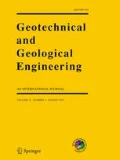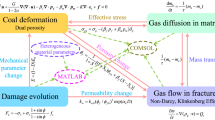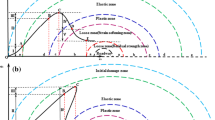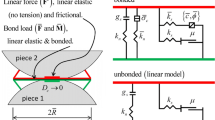Abstract
Along with the increase of mining depth, the dynamic disasters related to the instability and destruction of coal-rock are becoming more and more serious. In this paper, the uniaxial compression model of coal-rock was established by means of the micro particle flow PFC2D software firstly, and then the variation of stress field and damage field of coal-rock were analysed. Finally, the time–space constitutive model of coal-rock was discussed and modified. The research results show that: the compression stress field of coal-rock has obvious time–space effect, and along with the change of compressive stress, the stress field was transferred to the inner coal-rock body; the coal-rock damage evolution process has a similar temporal and spatial relations with the stress field evolution, the number of damage cracks were increasing with the constant change of compressive stress, and transferred to the inner coal-rock body with “string wave” feature; the time–space damage constitutive model of coal-rock established on the basis of local crack and the stress concentration factor of coal-rock was reasonable and effective, the damage degree of the whole coal-rock could be predicted by the variation of local coal-rock stress and cracks. In overall, the successful verification of the time–space relationship of coal-rock damage and stress transfer indicated that the possibility of using the constitutive model developed in this study to investigate coal-rock stability in coal mine.








Similar content being viewed by others
References
Cao S, Xian X (2001) Testing study on the characteristics of creep and damage of coal and other rocks. Chin J Rock Mech Eng 20(6):817–822
Carranza-Torres C, Fairhurst C (1999) The elasto-plastic response of underground excavations in rock masses that satisfy the Hoek-Brown failure criterion. Int J Rock Mech Min Sci 36(6):777–809
Cundall PA, Strack OD (1979) A discrete numerical model for granular assemblies. Geotechnique 29(1):47–65
Ge X, Ren J, Pu Y et al (1999) A real-time CT triaxial testing study off meso-damage evolution law of coal. Chin J Rock Mech Eng 18(5):497–502
Itasca Consulting Group (2008) PFC2D (particle flow code in 2dimensions) fish in PFC2D. Itasca Consulting Group, Minneapolis
Itasca Consulting Group Inc. (2004) Manual of particle flow code in 2-dimension (Version 3.10). Itasca Consulting Group Inc., Minneapolis
Iturrioz I, Lacidogna G, Carpinteri A (2013) Acoustic emission detection in concrete specimens: experimental analysis and lattice model simulations. Int J Damage Mech 23(3):327–358
Ju Y, Zuo J, Song Z et al (2007) Numerical simulation of stress distribution and displacement of rock strata of coal mines by means of DDA method. Chin J Geotech Eng 29(2):268–273
Kachanov LM (1958) Time rupture process under creep conditions. Izvestia Akademii Nauk SSSR, Otdelenie Tekhnicheskich Nauk 12(8):26–31
Khaled MM, Michael MM, Heather EL et al (2016) Analysis of the current rib support practices and techniques in U.S. coal mines. Int J Min Sci Technol 26(1):77–87
Kim J, Yi J, Kim J et al (2013) Fatigue life prediction methodology using entropy index of stress interaction and crack severity index of effective stress. Int J Damage Mech 22(22):375–392
Kupchella R, Stowe D, Xiao X et al (2015) Incorporation of material variability in the Johnson Cook model. Procedia Eng 103:318–325
Lemaitre J, Sermage JP, Desmorat R (1999) A two scale damage concept applied to fatigue. Int J Fract 97(1–4):67–81
Li Z (1987) Study on mechanism of coal and gas outburst in in-seam drivage. J China Coal Soc 1:17–27
Liu G, Zhao J, Song H et al (2008) Model experiments on the broken zone in intermittently jointed surrounding rock. J China Univ Min Technol 37(1):62–66
Matsuki K, Nakama S, Sato T (2009) Estimation of regional stress by FEM for a heterogeneous rock mass with a large fault. Int J Rock Mech Min Sci 46(1):31–50
Mizuno M, Okayasu M, Odagiri N (2010) Damage evaluation of piezoelectric ceramics from the variation of the elastic coefficient under static compressive stress. Int J Damage Mech 19(3):375–390
Murti V, Zhang W, Valliappan S (1991) Stress invariants in an orthotropic damage space. Eng Fract Mech 40(6):985–990
Peng Y, Qi Q, Wang Y et al (2010) Study of field measurement of mining induced coal fracture field and its application. J Rock Mech Eng 29(S2):4188–4193
Rabotnov YN (1969) Creep rupture. Applied mechanics. Springer, Berlin, pp 342–349
Ren J, Ge X (2001) Study of rock meso-damage evolution law and its constitutive model under uniaxial compression loading. Chin J Rock Mech Eng 20(4):425–431
Voyiadjis GZ, Kattan PI (2015) Investigation of the damage variable basic issues in continuum damage and healing mechanics. Mech Res Commun 68:89–94
Wen Z, Wang X, Song Z et al (2015) Study on bearing mechanical behaviour of the pre-damaged coal rock. J Mines Met Fuels 63(9):246–250
Xiang-he PENG, Chun-he YANG (2000) The damage and its description of concrete under complex loading history. Chin J Rock Mech Eng 19(2):157–164
Yin X (2008) Numerical tests on geotechnical properties of rock and soil materials. Wuhan Institute of rock and soil mechanics, Chinese Academy of Sciences, Wuhan
Zhang M, Xu Z, Pan Y (1991) A united instability theory on coal (rock) burst and outburst. J China Coal Soc 16(4):48–53
Zhang X, Ruan H, Jia C (2010) Progress in theory of damage mechanics of rock. Sichuan Build Sci Res 36(2):134–138
Acknowledgments
This work is supported by the National Basic Research Program of China under Grant No. 2012CB72310402; the National Natural Science Foundation of China under Grant No. 51304126; the research fund for excellent young and middle-aged scientists of Shandong Province under Grant No. BS2013NJ007; Fok Ying Tung Education Foundation under Grant No. 141046; State Key Laboratory of open funds under Grant No. SKLGDUEK1520; Shandong University of Science and Technology Graduate Innovation Fund No. YC150309; the Tai’shan Scholar Engineering Constructin Fund of Shandong Province of China.
Author information
Authors and Affiliations
Corresponding author
Rights and permissions
About this article
Cite this article
Wang, X., Wen, Zj. & Jiang, Yj. Time–Space Effect of Stress Field and Damage Evolution Law of Compressed Coal-Rock. Geotech Geol Eng 34, 1933–1940 (2016). https://doi.org/10.1007/s10706-016-0074-y
Received:
Accepted:
Published:
Issue Date:
DOI: https://doi.org/10.1007/s10706-016-0074-y




